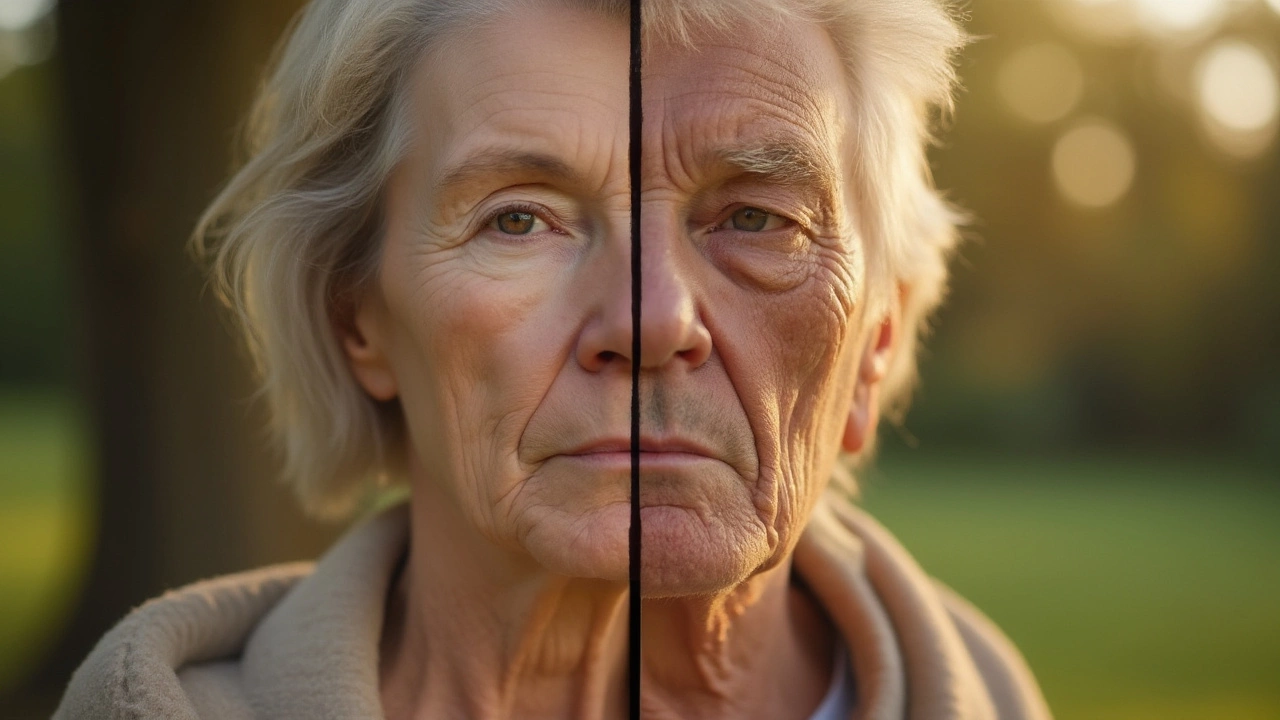When Do Jowls Start to Appear? Causes, Timeline & Prevention Tips
 Jul, 9 2025
Jul, 9 2025
Think you’ll wake up one day and just spot your first jowls staring back in the mirror? It’s rarely that sudden, but the telltale droop along your jawline can feel like it comes out of nowhere. One week your cheeks are firm and youthful, the next, there’s a shadow at your chin, and no filter seems to help. This whole business of jowls isn’t just frustrating—it's got a backstory written deep in our skin, our genes, and even our daily habits. If you’re wondering not only “at what age do jowls start?” but “can I stop them?”—you’re definitely not alone. Let’s get real about when sagging begins, what’s actually going on, and how much power you have to keep your jawline sharp, with some science sprinkled in.
Why Do Jowls Form, Anyway?
Jowls aren’t just the result of aging—they’re part biology, part lifestyle, and a dash of unfair luck. Under our skin, a lot is happening with age. Our bodies make less collagen and elastin (the fibers that keep skin bouncy and firm), and this starts way earlier than you might guess: collagen production actually begins to drop by your mid-20s. You won’t spot jowls while you’re still using your college ID, but slow changes are already happening, so when jowls appear, it’s not “overnight”—it’s years in the making.
Gravity doesn’t let up, either. Day by day, it tugs on aging skin, and with less structural support, that skin starts to migrate southward. The facial fat pads, which once gently cushion your cheeks, break down and slide, accentuating the sag under your jaw. Genetics play a huge role—if you’re seeing your mom’s or dad’s lower cheek silhouette in your own reflection, it’s not just your imagination. Some people naturally have thicker skin or more robust support—a definite advantage.
Lifestyle? Huge. Smoking isn’t just bad for your lungs—it actually damages the tiny blood vessels feeding your skin, reducing the supply of fresh nutrients and making skin more likely to sag. Major sun exposure without protection leads to faster collagen collapse and earlier jowling. Even dramatic weight loss or frequent yoyo dieting can leave skin looser and more prone to droop, since the skin stretches but may not fully snap back.
By the way, no gender gets spared—though structure and hormones do shift the timeline a bit. Estrogen levels, for example, drop in women after menopause, and that speeds up collagen loss. Guys often have thicker skin, which can offer a little extra time, but by the late 40s to early 50s, it’s a pretty level playing field.

Pinpointing the Age Jowls Start Appearing
Let’s get specific—when do jowls really show up? Most dermatologists say the earliest hints can start as soon as your mid-30s, but for the average person, they’re typically noticeable in the early to mid-40s. There’s no exact birthday where it kicks in. By age 50, almost everyone will see some degree of jowling unless they have exceptional genetics or have already had cosmetic procedures.
Family history is a huge indicator. If your parents started seeing sag by their late 30s, chances are your timeline will be similar. That said, different facial structures show jowls more or less obviously. Heart-shaped faces keep it hidden a little longer, while a squarer jawline will show it sooner.
To really drive it home, let’s look at a quick breakdown from a large dermatology review in 2022. Researchers asked 800 people when they first noticed sagging around their jawline. Here’s what they found:
| Age Group | % Reporting Noticeable Jowls |
|---|---|
| 30-39 | 8% |
| 40-49 | 51% |
| 50-59 | 82% |
| 60+ | 98% |
There are always outliers, but if you’re starting to see a softening or a shadow where your cheek meets your jaw in your early 40s, you’re right in the thick of the normal window. Seriously, nobody else notices it as much as you do, especially if you’re the one squinting into the magnifying side of the mirror.
Now, here’s the thing: the speed at which jowls appear can ramp up pretty fast. Once those support structures weaken, change can seem quick—especially if you’re experiencing big hormonal shifts, recovering from major weight loss, or going through a super stressful time. Stress, believe it or not, can nudge your skin into aging faster by spiking cortisol, which messes with collagen production and hydration.
Some folks in hot, sunny climates—or who never wore sunscreen in youth—report their jowls arriving a few years sooner than average. And yes, pollution counts, too. Living in a big city or around lots of air pollution accelerates oxidative stress, which in turn makes *jowls* show up earlier.

Preventing and Minimizing Jowls: Real-World Tips That Work
If you’re reading all this thinking “welp, it’s fate,” hang on. You have a lot of power over when and how much your jawline sags. Start with simple daily prevention: daily broad-spectrum sunscreen is a must (not optional), even if you’re not tanning. UVA rays get through clouds and glass, breaking down your collagen. SPF 30 or higher, always. Don’t forget your neck and jaw—it’s all one canvas.
Next up: don’t underestimate your skincare basics. Prescription-strength retinoids have the strongest anti-aging evidence, boosting collagen and improving skin texture over time. For over the counter options, look for retinol or bakuchiol (which is like retinol’s gentle cousin). Moisturizing isn’t just for comfort—it helps skin stay plumper, looking less slack.
Lifestyle changes count big time. Eat more antioxidants: berries, dark leafy greens, nuts. These help your skin fend off everyday damage from the sun and pollution. Regular strength training (even bodyweight exercises) can slow down muscle loss in your face, too. And try to sleep on your back—pressing your face into the pillow every night can speed up sagging on one side of your face or jaw.
For something more targeted, facial massage and microcurrent devices are trending for a reason. While results are subtle and best for prevention, they get blood flowing and can help tone the muscles just under your skin. Be consistent—a once-in-a-while effort won’t cut it.
Professional treatments? There’s a menu. In-office options like radiofrequency therapy, microneedling combined with PRP (platelet-rich plasma), and even focused ultrasound are becoming popular. None of these require surgery and can tighten skin gradually. Of course, the gold standard for dramatic change is a lower facelift, but that’s definitely not for everyone. Fillers might camouflage mild jowling by restoring volume around the chin or jawline—just know that outcomes really depend on the skill of your practitioner.
And yes—smoking. If you’re still lighting up, know that quitting now could delay sagging by years. Studies show smokers lose collagen up to 25% faster than non-smokers. Not exactly a cute perk.
- Jowls typically start showing between the early 40s and 50s, but you can act today to slow the process.
- Daily sunscreen, antioxidants, and good sleep habits aren’t glamorous, but they seriously work.
- If you’re already seeing sag, non-invasive treatments can make a real difference without knives or scary downtime.
- And hey: next time you see a selfie with a softer chin line, cut yourself some slack. You’re in good company—and looking after your skin pays off no matter when you start.
So, when someone asks you, “At what age do jowls start?” you can tell them: it’s different for everybody, but there’s loads we can do—with a bit of science, smart habits, and self-kindness—to keep that jawline lifted as long as possible.
